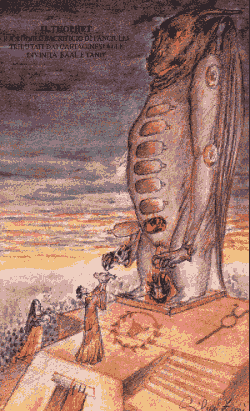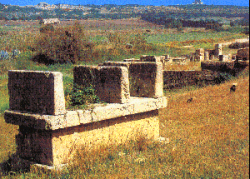
| Come and Hear™ to increase interfaith understanding http://www.come-and-hear.com This page has been cached from its original location to ensure availability for future students of Come and Hear™ |

 The
rite of the human sacrifice "Molk" as a sacfed offering is peculiar of a
mentality which didn't exist in the Greek or Roman society.
The
rite of the human sacrifice "Molk" as a sacfed offering is peculiar of a
mentality which didn't exist in the Greek or Roman society.If Phoenicians thought that a God wanted the destruction of a town or a country, they didn't esitate to offer him human lives, avoiding in this way the anger and the curse of the god and blaming on few people.
As they believed no other sacrifices better than this could appease the anger of that god, carthaginins vowed themselves to the human sacrifices and in order to insrease the value of the sacrifice, they offered even their children's life.
Consequently, in particular troubled situations they offered the so-called "early
fruits" (and among them the first-borns) to the God Baal, who ensured richness and
answered prayers and to the Goddess Tanit, who protected the town and granted its
eternity.
The sacrifice of human lives, animals and children divinized the sacrified children.
In this way there was a direct "channel of communication" with gods.
Sometimes people replaced children with animals (Molchomor), but it wasn't always
possible.
Seldom gods required human blood or flesh in change of their precious favours.
Widespread were sacrifices of birds, lambs and sheeps.
The sacrifice "Molk" itself foresaw an eventual substitution of children with
animal victims.
The terrible ceremony of the human sacrifice was made more gloomy by the forbidding to relatives to show their sorrow before tha altar.
In fact tears and moans could diminish the value of the sacrifice.
Diodorus from Sicily, historian from Agira, remembered the sacrifice of 200 children taken
from the richest families of Carthago.
Children coming from the best families of the town were replaced by children bought or
adopted by poor families; afterward, in order to beg pardon for the sin committed,
Carthago's government ordained the sacrifice of 200 children all belonging to noble
families.
Silvius Italicus in the fourth book of his "epopea" told with richness of
details the case of Hannibal's son.
Carthago's government decided to sacrify him.
Imilce, the Spanish soldier's wife, was opposed to that terrible decision obtaining from the Council the suspension of the sacrifice to inform her husband; Hannibal refused to sacrify his son and in change of him he swore to sacrify thousand of enemies.
 G. H. Hertzberga
precised the rite of that sacrifice.
G. H. Hertzberga
precised the rite of that sacrifice.
On the basis of the number of children destined to it, by lot it was chosen the victim, who was regularly and secretly substituted by that of other people.
The child, placed in the arms of a bronze empty idol, rolled inside it, where a fire was burning.
Gustave Flaubert, in his historical novel "Salambo'", wrote:" Children slowly got on the ladder.
No one moved, because they were tied in the wrists and ankles and the black veil which
wrapped them didn't allow them to see and the crowd to recognize them".
James B. Fevrier told:" It's nightime! Some flute and drum players made a great
noise.
Mother and father are there.
They gave the child to the priest, who walked along the hole of the sacrifice, cut the
throat to the child misteriously, then he placed the little victim on the offering hands
of the God's statue from which it rolled into the rogue".
Sabatino Moscati, a well-known Semitist, holds the theory that the sacrifice of the children is mere fantasy and that the "Tophet" (sacred area) is a sacred place of burial of dead born children or dead after their birth, burned and buried in urns.
The problem regarding the sacrifice is still open, even if having found in the "Tophet" little animals remains (maybe children victims) confirms the terrible rite of the Carthaginian religion.
At the end, in a draw reproduced on the "stele obelisco" ( a man wearing a transparent tunic holding a child in his arms) there is a scene of a "priest with child".
In Selinunte three sacred areas were discovered.
The most important is constituted by a complex consisting in twelve rooms bound one to
each other (two of them formed the central part) where thirteen vases were found,
amphorae, containing animals bones, mixed to burnt material.
The amphorae are "torpedo kind", a typical Punic amphora; others are globe-like, with a cord edge.
![]() CITY OF CASTELVETRANO - SELINUNTE (TP)
CITY OF CASTELVETRANO - SELINUNTE (TP)
E-Mail : [email protected] -
[email protected]